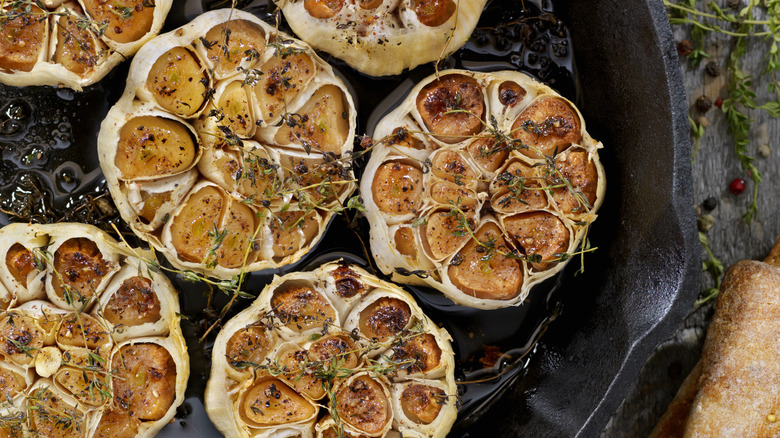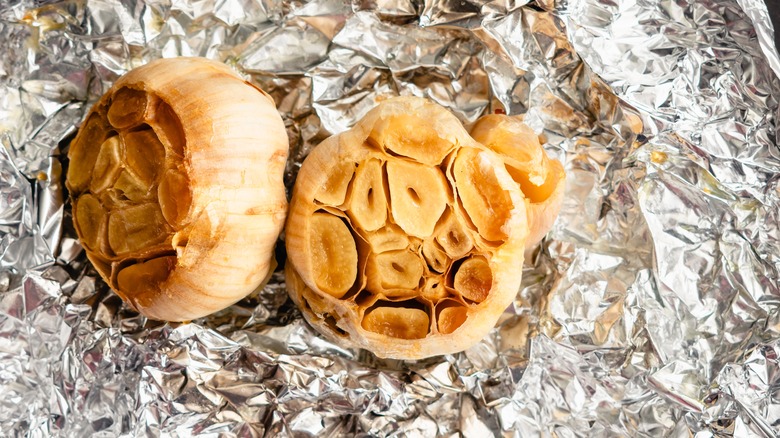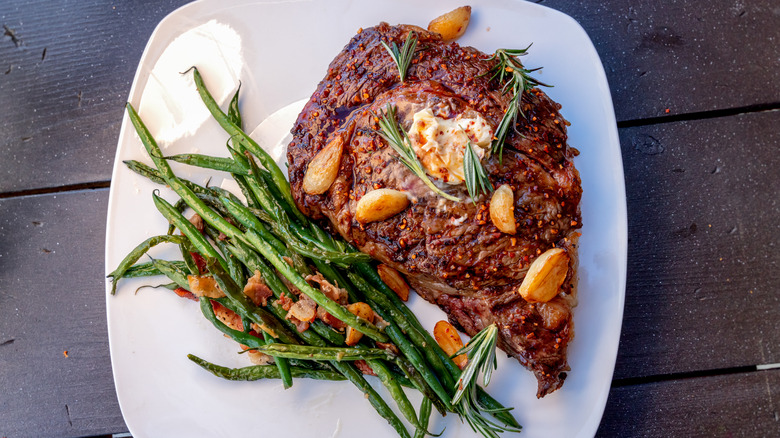What's The Difference Between Caramelized And Roasted Garlic?
Garlic's strong, rich flavors make it a popular addition to a whole slew of recipes, from warming stews to bright sauces, and myriad more. Two of the most popular ways to prepare garlic are to roast or caramelize it, as both mellow the intense flavors of raw garlic by releasing its inner sweetness. Despite the similarities in the cooking methods, there are subtle differences between them.
Roasting garlic means enveloping it in dry heat, for approximately an hour, usually in an oven but any cooking surface that gets to 300 degrees Fahrenheit or hotter can work. The garlic is usually drizzled in olive oil to keep it moist during roasting. The surface of the cloves will be golden brown and soft once roasting is complete.
To caramelize garlic, you'll still need dry heat and oil, but after starting hot to jumpstart the process, you cook your garlic at slightly lower temperatures for a longer time. When garlic is in the lower heat for a prolonged period, the sugars inside are released more slowly, and the flavor of the garlic is transformed. This effect also happens with roasting, but because of the lower heat levels and longer cooking times used with caramelizing, the sugars have more time to permeate throughout the softened cloves, while roasting's effect is slightly more surface level by comparison.
Ways to roast, and caramelize, garlic
Roasting is a great way to cook garlic, as is caramelizing, to get the cloves brown, sweet, and soft. In an oven is probably the most common way, but caramelizing or roasting garlic in a slow cooker, a saucepan, or even an air fryer are also effective options. The air-fryer method works the same as the oven; preparing garlic in a pan is as simple as throwing in your cloves and cooking them until the skin is blackened on all sides; and a slow cooker is touted as a way to avoid accidentally burning your garlic. To caramelize using these methods, you just turn the heat down lower and give the sugars even more time to release and the cloves to soften.
To store your roasted or caramelized garlic, wait for it to cool, then cover it with olive oil and seal it in an airtight container. You can keep garlic sealed in the fridge like this for up to two weeks, but the sooner you use it, the better. The best part about roasted and caramelized garlic? You don't need to do anything special to reheat it. Just throw it into a pot or pan with the rest of your next recipe's ingredients and those lovely savory flavors will release as it warms back up.
Tasty ways to enjoy roasted and caramelized garlic
Spreading roasted or caramelized garlic onto toasted bread is an easy way to make garlic bread or to use it as a condiment for sandwiches. Cooked garlic can add bite to fan-favorite dips such as hummus or fresh tzatziki, and give a kick to salad dressings. Garlic's buttery flavors enliven a lackluster soup or stew and take a well-grilled steak from savory and satisfying to truly stratospheric, which is why it's always a good idea to keep a few bulbs on hand.
Roasting and caramelizing work with many root vegetables, too. Carrots or parsnips burst with beautiful, earthy aromatics when roasted, and pair brilliantly with saucy stir-fries, creamy pasta dishes, or in a hearty, easy beef stew. Vegetables with a high sugar content like sweet potatoes are great when caramelized — more sugar means more sweet, deep caramelly flavor.
Roasting and caramelizing may be two different cooking techniques, but they both create delicious results, especially when it comes to garlic. Roasted and caramelized garlic can take almost any dish from bland to bursting with flavor, so don't skimp on those cloves.


